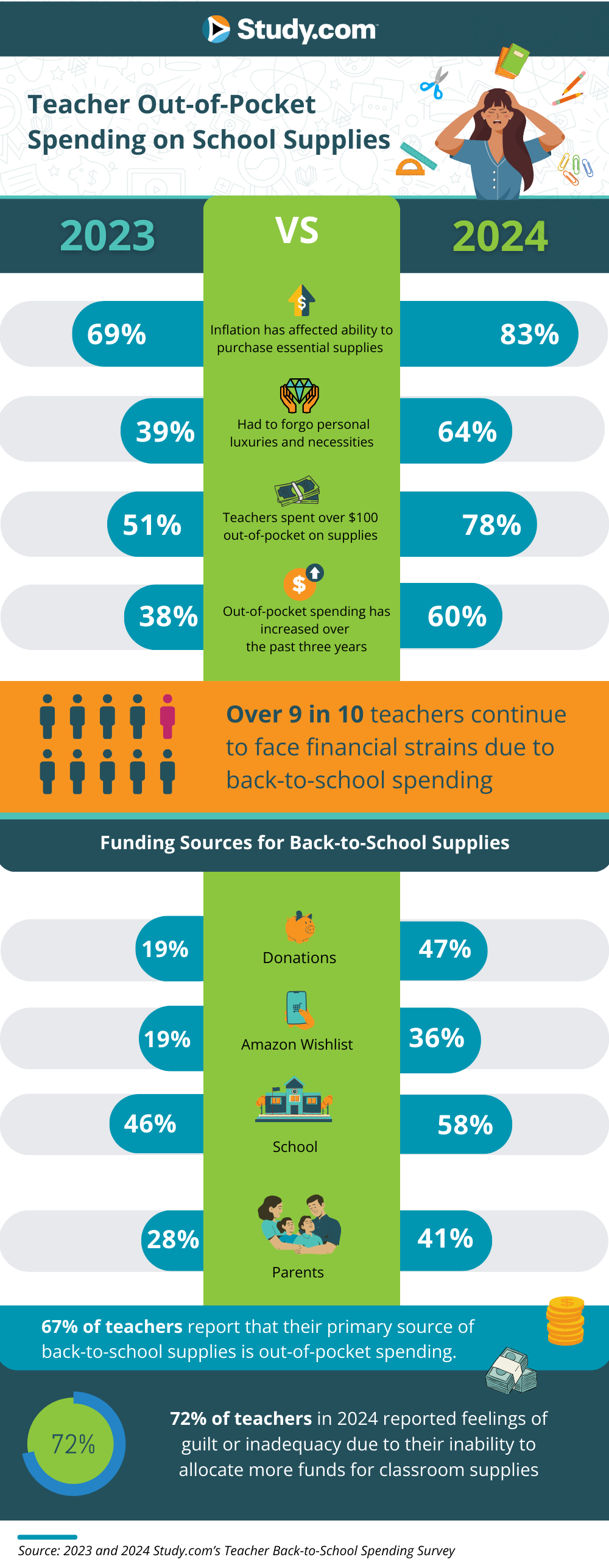Teachers vs. inflation: 83% struggling to afford essential back-to-school supplies in 2024

RoseLife_Family // Shutterstock
Teachers vs. inflation: 83% struggling to afford essential back-to-school supplies in 2024
A teacher’s hands holding a box of school supplies.
School is back in session and many teachers are already facing growing financial challenges, Study.com reports. 83% of educators, up from 69% in 2023, report that inflation has made it harder to buy necessary classroom supplies. This increase sheds light on a growing issue in education: rising costs and flat salaries are leaving teachers struggling to support their classrooms.
A report from the National Education Association indicates that this problem is widespread and shows that teacher salaries, when adjusted for inflation, have decreased by 5% over the last decade, reducing their buying power significantly. In 2020, Teachers spent an average of $459 out of their own pockets on supplies each year, on top of the unaccounted fees of cleaning supplies during the COVID-19 pandemic, according to the Economic Policy Institute, with zero reimbursement.
Schools are feeling the strain, too. The Center on Budget and Policy Priorities found that, since the Great Recession, more than half of U.S. states have cut education funding per student, even after adjusting for inflation. Now, teachers are often expected to cover gaps with their own money, adding to their financial stress.
“We have families who can’t afford all the school supplies, so we get it for them because the students can’t learn if they don’t have the tools or materials,” Mindy Tuft, a teacher from a Title I school in Sacramento County, shares to Study.com.
Survey Methodology: The 2024 Study.com survey included responses from 500 teachers across the U.S., up from 367 in 2023, aiming to capture a fuller picture of the economic pressures educators are facing today. Additional data comes from recent news and studies from the National Education Association, Economic Policy Institute, Center on Budget and Policy Priorities, FinanceBuzz, Deloitte. The findings underline the urgent need for action to support teachers who are stretched thin financially and ensure that they have the resources necessary to provide quality education.
![]()

Study.com
The Hidden Costs of Teaching in 2024
An infographic showing data on “Teacher Out-of-Pocket Spending on School Supplies”.
Teaching has always come with hidden costs, but in 2024, these expenses are escalating. According to the National Retail Federation and the National Education Association, 94% of teachers spend their own money on classroom materials, with the average out-of-pocket expense rising by 23.7% over the past two years.
Lauren Erikson, a teacher on special assignment from Monterey County, California, shared her personal experience: “Even now, I still spend money out of pocket for things, for supplies. For instance, in kindergarten classes, the school provides these very long, heavy pencils that are just too cumbersome for little hands learning to write. The supplies provided aren’t always what we need, so teachers end up covering the gap themselves.”
Inflation’s Broader Impact on Back-to-School Spending
While inflation is significantly impacting teachers, it’s also having an impact on parents’ budgets, where many are expected to spend $586 on back-to-school supplies this year, per student. That’s more than $1000 for families with more than one child. These rising costs strain both household budgets and educational resources, creating a domino effect that affects everyone involved in the school community.
Teachers have been hit particularly hard. They’re facing rising supply costs while their wages remain stagnant. Adjusted for inflation, teacher salaries have decreased by 5% over the past decade, according to the NEA. This means educators are spending more of their own money while earning less in real terms.
Erikson adds: “The cost of living in California is high, and many teachers have to work extra jobs over the summer or during school breaks just to make ends meet. In our district, teachers can choose to be paid over ten or twelve months, which helps a little, but the financial stress is still very real.”
The Psychological Toll on Educators
The financial strain is also taking a psychological toll on educators. Many teachers report feelings of guilt and inadequacy because they can’t provide enough resources for their students. In fact, 72% of teachers in 2024 felt guilty about not being able to allocate more funds for classroom resources, a sharp increase from previous years.
This financial and emotional burden contributes to burnout and is a significant factor driving teachers out of the profession. As more educators consider leaving due to these compounding pressures, the need for systemic change becomes increasingly evident.
“Most teachers that I know spend between $200 and $500 a year on school supplies for their kids. When I did summer school, I bought them all notebooks because we didn’t have anything. I had a computer, but not all of the students did; I couldn’t make copies, so I bought them all notebooks, brought in pens, and bought everything for that summer,” Brandie Provenzano, a high school English teacher in Prince William County, Virginia.
Possible Solutions and Calls to Action
Increased school funding, better teacher pay, and robust support systems are some of the systemic solutions that could address these challenges, but that’s just a start. Legislative efforts like the Pay Teachers Act aim to address some of these financial burdens.
Teachers are calling for more community involvement, too, urging parents and local organizations to support schools through donations and advocacy for better funding. Understanding the challenges educators face is the first step toward meaningful change.
With data work by Alina Lehtinen-Vela.
This story was produced by Study.com and reviewed and distributed by Stacker Media.